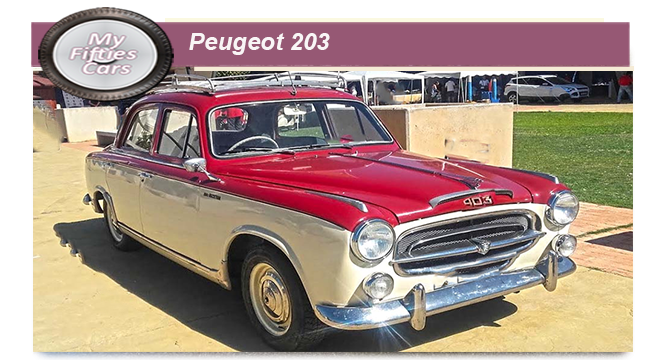 The Peugeot 403 series, released in 1955, had an entirely different external appearance with a rounded, boxy slab-sided body than the 203 that it was meant to replace.
The Peugeot 403 series, released in 1955, had an entirely different external appearance with a rounded, boxy slab-sided body than the 203 that it was meant to replace.
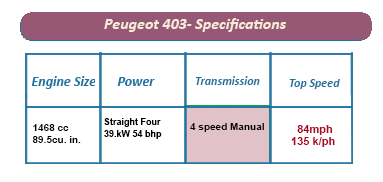 Initially planned as a replacement for the favourite 203, the 403 instead complemented the smaller car in Peugeot's line-up for its first five years. Similar in concept, but featuring more substantial Pininfarina-styled bodywork, the 403 was a spacious and well-built machine for those in the search for practicality over power.
Initially planned as a replacement for the favourite 203, the 403 instead complemented the smaller car in Peugeot's line-up for its first five years. Similar in concept, but featuring more substantial Pininfarina-styled bodywork, the 403 was a spacious and well-built machine for those in the search for practicality over power.
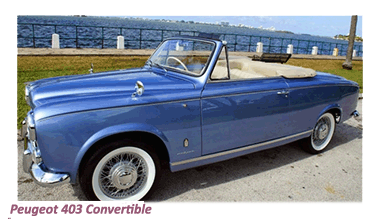 The body of this latest 403 was designed on behalf of Peugeot by Pininfarina in Turin. Their brief was to develop a vehicle that was more spacious than the 203 although mechanically the two should have much in common.
The body of this latest 403 was designed on behalf of Peugeot by Pininfarina in Turin. Their brief was to develop a vehicle that was more spacious than the 203 although mechanically the two should have much in common.
Basic models came with the 203's 1290cc (79 cu in) engine, although a bored-out 1468cc (90 cu in) version was released for those who were looking for a little more power from their Peugeot.
 The engine as paired with a four-speed synchromesh gearbox that even had overdrive on the top gear, controlled by a column-mounted gear lever that made even the 403 sedans a true six-seater.
The engine as paired with a four-speed synchromesh gearbox that even had overdrive on the top gear, controlled by a column-mounted gear lever that made even the 403 sedans a true six-seater.
Considerately taking into account the comfort of the sixth occupant, who, by the necessity of design, was always crammed between the driver and front passenger. Peugeot brought in the choice of automatic transmission in 1958.
![]()
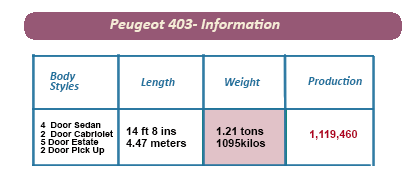 In keeping with what was becoming standard Peugeot practice, the 403 was available in a choice of body forms.
In keeping with what was becoming standard Peugeot practice, the 403 was available in a choice of body forms.
>Apart from the basic four-door sedan, the 403 was available in a five-door station wagon or two-door pickup format- tried and tested permutations that the French public lapped up.
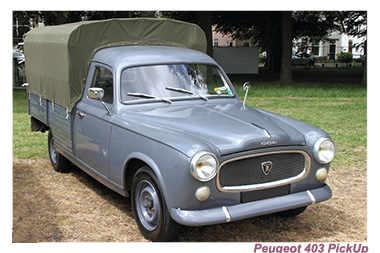 A convertible version was released later but was not the subject of tremendous accolades.
A convertible version was released later but was not the subject of tremendous accolades.
On the other hand, the 403 eight-seat estate permutation, available from 1956 turned out to be the jewel in the crown for Peugeot.
> The Peugeot 403 " Familiale Estate" could be specified with eight seats arranged in three rows.
The Peugeot 403 " Familiale Estate" could be specified with eight seats arranged in three rows.
History would go on to show that the " Familiale" was significantly ahead of its time, a forerunner of the large SUVs found today,
While the Pininfarina was necessarily bland, the 403 stood out for its oval grille had a horizontal 11 bar and centre insignia while a '403' model designation sat prominently on the hood front.
![]()
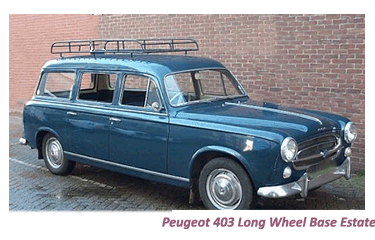 Despite its lack of interior trim, the 403 came equipped with a sliding roof, reclining front seats and folding armrests, both front and rear, as standard.
Despite its lack of interior trim, the 403 came equipped with a sliding roof, reclining front seats and folding armrests, both front and rear, as standard.
 In most respects, the 403 was a conservative machine, a workhorse ideally suited for the time that France and Western Europe was severely in need of such a vehicle.
The million-plus 403s that Peugeot sold during its production run says it all, with its large percentage of export sales playing a fundamental part in bringing Peugeot — and the French economy — back from the brink of post-war bankruptcy.
In most respects, the 403 was a conservative machine, a workhorse ideally suited for the time that France and Western Europe was severely in need of such a vehicle.
The million-plus 403s that Peugeot sold during its production run says it all, with its large percentage of export sales playing a fundamental part in bringing Peugeot — and the French economy — back from the brink of post-war bankruptcy.


